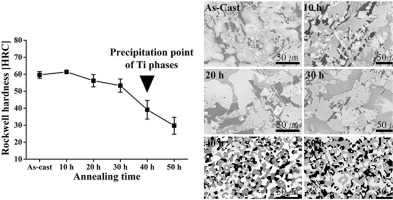当前位置:
X-MOL 学术
›
J. Alloys Compd.
›
论文详情
Our official English website, www.x-mol.net, welcomes your
feedback! (Note: you will need to create a separate account there.)
Microstructural and mechanical evaluation of Nb-silicide-based in situ composite at ultrahigh temperature
Journal of Alloys and Compounds ( IF 5.8 ) Pub Date : 2020-01-01 , DOI: 10.1016/j.jallcom.2019.152318 Tae-Wook Na , Jong Min Park , Ki Beom Park , Seong Lee , Donghoon Kim , Kwangsuk Park , Hyung-Ki Park , Taeg Woo Lee
Journal of Alloys and Compounds ( IF 5.8 ) Pub Date : 2020-01-01 , DOI: 10.1016/j.jallcom.2019.152318 Tae-Wook Na , Jong Min Park , Ki Beom Park , Seong Lee , Donghoon Kim , Kwangsuk Park , Hyung-Ki Park , Taeg Woo Lee

|
Abstract This study evaluated the thermal degradation mode of Nb-silicide-based in situ composite (Nb–19Ti–16Si-4Hf-13Cr–2Al–4B at.%) when exposed to temperatures up to 1600 °C in Ar atmosphere. For evaluation, the Rockwell hardness test, X-ray diffraction (XRD), scanning electron microscopy (SEM), and transmission electron microscopy (TEM) equipped with an energy-dispersive spectroscopy (EDS) were used. The as-manufactured specimen was composed of Nb solid solution (Nbss), Laves phase, and two types of silicides ((Nb,Ti,Hf)5Si3) that have hexagonal and tetragonal crystal structures, respectively. Exposed to ultrahigh temperatures, the resulting degradation and transformation of silicides led to the precipitation of face centered cubic (FCC)–Ti phases, which occurred predominantly after 40 h exposure. The decrease in volume fraction of silicide seems to be attributable to decomposition of the silicide, by which phase separation between the silicide and Ti phases occurred owing to the high vapor pressure of Si. As a result, the hardness (HRC) decreased from about 60 to 30. The results show that the evaporation of elemental Si needs to be considered for achieving good thermal oxidation resistance in Nb silicide composites. The results further suggest that one solution for improving the fracture toughness of Nb silicide composites is via control of the microstructure.
中文翻译:

Nb-硅化物基原位复合材料的超高温显微组织和力学性能评价
摘要 本研究评估了 Nb-硅化物基原位复合材料 (Nb-19Ti-16Si-4Hf-13Cr-2Al-4B at.%) 在 Ar 气氛中暴露于高达 1600 °C 的温度时的热降解模式。为了评估,使用了洛氏硬度测试、X 射线衍射 (XRD)、扫描电子显微镜 (SEM) 和配备能量色散光谱 (EDS) 的透射电子显微镜 (TEM)。制成的试样由 Nb 固溶体 (Nbss)、Laves 相和两种分别具有六方和四方晶体结构的硅化物 ((Nb,Ti,Hf)5Si3) 组成。暴露在超高温下,由此产生的硅化物降解和转变导致面心立方 (FCC)-Ti 相的沉淀,这主要发生在暴露 40 小时后。硅化物体积分数的降低似乎归因于硅化物的分解,由于Si的高蒸气压,硅化物和Ti相之间发生相分离。结果,硬度 (HRC) 从约 60 降至 30。结果表明,需要考虑元素 Si 的蒸发,以在 Nb 硅化物复合材料中实现良好的抗热氧化性。结果进一步表明,提高 Nb 硅化物复合材料断裂韧性的一种解决方案是通过控制微观结构。结果表明,为了在 Nb 硅化物复合材料中实现良好的抗热氧化性,需要考虑元素 Si 的蒸发。结果进一步表明,提高 Nb 硅化物复合材料断裂韧性的一种解决方案是通过控制微观结构。结果表明,为了在 Nb 硅化物复合材料中实现良好的抗热氧化性,需要考虑元素 Si 的蒸发。结果进一步表明,提高 Nb 硅化物复合材料断裂韧性的一种解决方案是通过控制微观结构。
更新日期:2020-01-01
中文翻译:

Nb-硅化物基原位复合材料的超高温显微组织和力学性能评价
摘要 本研究评估了 Nb-硅化物基原位复合材料 (Nb-19Ti-16Si-4Hf-13Cr-2Al-4B at.%) 在 Ar 气氛中暴露于高达 1600 °C 的温度时的热降解模式。为了评估,使用了洛氏硬度测试、X 射线衍射 (XRD)、扫描电子显微镜 (SEM) 和配备能量色散光谱 (EDS) 的透射电子显微镜 (TEM)。制成的试样由 Nb 固溶体 (Nbss)、Laves 相和两种分别具有六方和四方晶体结构的硅化物 ((Nb,Ti,Hf)5Si3) 组成。暴露在超高温下,由此产生的硅化物降解和转变导致面心立方 (FCC)-Ti 相的沉淀,这主要发生在暴露 40 小时后。硅化物体积分数的降低似乎归因于硅化物的分解,由于Si的高蒸气压,硅化物和Ti相之间发生相分离。结果,硬度 (HRC) 从约 60 降至 30。结果表明,需要考虑元素 Si 的蒸发,以在 Nb 硅化物复合材料中实现良好的抗热氧化性。结果进一步表明,提高 Nb 硅化物复合材料断裂韧性的一种解决方案是通过控制微观结构。结果表明,为了在 Nb 硅化物复合材料中实现良好的抗热氧化性,需要考虑元素 Si 的蒸发。结果进一步表明,提高 Nb 硅化物复合材料断裂韧性的一种解决方案是通过控制微观结构。结果表明,为了在 Nb 硅化物复合材料中实现良好的抗热氧化性,需要考虑元素 Si 的蒸发。结果进一步表明,提高 Nb 硅化物复合材料断裂韧性的一种解决方案是通过控制微观结构。





















































 京公网安备 11010802027423号
京公网安备 11010802027423号